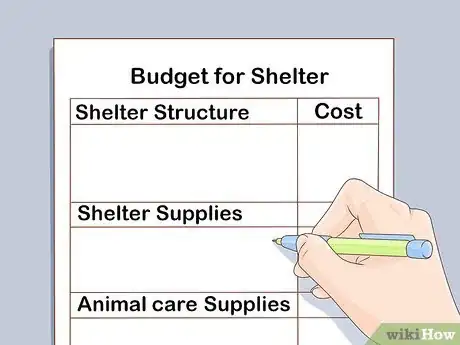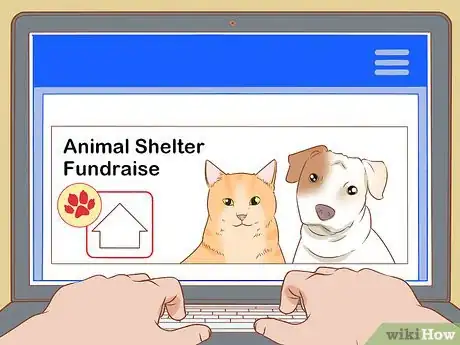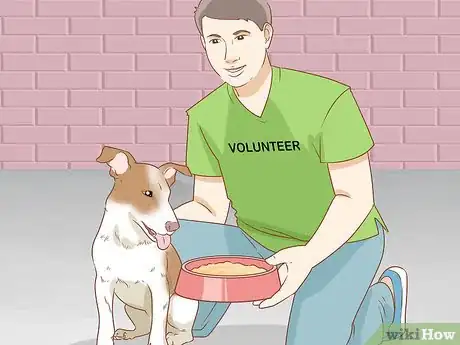This article was co-authored by wikiHow Staff. Our trained team of editors and researchers validate articles for accuracy and comprehensiveness. wikiHow's Content Management Team carefully monitors the work from our editorial staff to ensure that each article is backed by trusted research and meets our high quality standards.
wikiHow marks an article as reader-approved once it receives enough positive feedback. In this case, 96% of readers who voted found the article helpful, earning it our reader-approved status.
This article has been viewed 38,763 times.
Learn more...
Though you may have a strong desire to care for homeless or neglected animals, opening an animal shelter can be a major endeavor. You will need to demonstrate strong management and marketing skills as well as passion, drive, and energy to make your aspirations of starting an animal shelter a reality.
Steps
Getting Financing and Licensing
-
1Identify the animal shelter’s focus or speciality. Before you jump right into your plan for an animal shelter, you should consider how your shelter will differ from the other shelters in your area. If there is already an animal shelter that focuses on small dogs, for example, you may not want to also base your shelter around housing small dogs.[1]
- Think about a need in the community or in the animal adoption market that your animal shelter could fill. This could be older or elderly dogs who do not often get adopted or maimed animals that are not often accepted into larger animal shelters.
- This will also ensure that you are not competing with other animal shelters in your area and give your animal shelter a clear focus. Though the animal shelter is made for the wellbeing of animals, it is also a business. You should treat it as a business that needs to be sustainable and appealing.
-
2Create a budget for the shelter. Get your finances for the shelter in order by sitting down and drawing up a budget. The budget should cover all start up costs, all outgoing expenses, and all incoming funds. Your budget should cover:[2]
- Costs for the shelter structure: This should include rent payments or building maintenance payments. You may also need to cover heating, water, and electricity expenses.
- Shelter supplies: This should include any equipment needed to make the shelter functional for animals, food for the animals, cleaning materials, and waste disposal.
- Animal care supplies: This should include the costs for routine vet treatment, neutering services, microchipping, and animal toys.
- You may also need to insure your vehicle as a shelter vehicle to transport animals to and from the shelter.
Advertisement -
3Use part of your income as start up funding. Some animal shelter owners will treat the animal shelter as a part time job and will supplement the start up costs with their full time income at another job. This option is useful if you live in a household where two people both have stable, full time jobs and can donate a portion of their income to the shelter.
-
4Apply for government grants. Talk to your local chapter of The Humane Society and other national animal welfare associations to get a sense of government funding and what you might qualify for. Often, local governments will provide funding to animal shelters to help maintain animal welfare in the area and animal control.[3]
-
5Take out a business loan. Talk to your bank about taking out a small business loan to help fund your shelter. You will likely need to be making a steady income over a period of time to qualify for the loan.
-
6Fundraise in your area and online. You should also reach out to the community, local and online, to help support your shelter. Set up a fundraising campaign online to generate publicity for the shelter and to raise money.
- You can also organize a fundraising event with other animal shelters in the area or other animal related businesses. Collaborate with community partners to promote the fundraising event, as this will help promote the shelter as a valuable asset to the area.
-
7Apply for an animal shelter license. You can do this through your state’s department of agriculture. The cost for the licensing fee will depend on how many animals you plan to shelter at one time and can range from a $100 licensing fee for 20 or fewer pets to a $400 licensing fee for 80 or fewer pets.[4]
- To obtain a license, a city inspector will look at your animal shelter to ensure it is fit for animals. She will then collect the licensing fee from you and process your application.
Choosing a Shelter Location
-
1Determine the type of accommodations you want to offer animals. Though you may think of an animal shelter as a stand-alone building or structure that you rent or lease, you can also provide accommodations for animals in the form of a small indoor shelter built in your backyard or adapt an existing outdoor area to create a shelter. The size and type of the accommodation you choose will depend on the space available, your skills, your finances, and the local laws around animal shelters in your area. There are several accommodation options, including:[5] [6]
- A newly built animal shelter, which will be expensive and have high start-up costs, but may be easier to maintain than an existing structure.
- An indoor shelter in an existing structure, which is a cheaper option but could be harder to keep clean and maintain.
- A shed or outdoor shelter, which is another cheap option but could be more difficult to keep sanitary and stress free for the animals.
- Outdoor pens in a volunteer or community garden, which is a cheap and community-oriented option. However, you will need to determine who will pay for the maintenance of the shelter and have a contingency plan in the event the community space is moved.
- Fostering animals in your home, where you take care of one to two animals in your home at a time until they are adopted into other homes. This is not a full-blown animal shelter but it could be a good way to gain more experience in taking care of animals on your own.
-
2Decide how many animals you will accept at a time. Though it may be tempting to take in as many animals as you can in your new shelter, doing this could lead to overcrowding and unsanitary conditions for the animals. Instead, it’s best to put a cap on how many animals you will accept at one time, especially as you get your shelter up and running.[7]
- Some shelter owners start by taking two to three animals at a time and then expand from there. Many shelter owners suggest starting small and expanding slowly. In some states, animal shelters are permitted to have up to 80 pets at a time.[8]
- The number of animals you take in could be based on how much space you may have in the shelter location and how many animals you can take care of on your own or with a few volunteers. You should also consider if you are going to be working full time at the shelter or part time, as you may only have enough time to devote to a few rescue animals at a time.
- It is not mandatory that you decide which types of animals you are going to focus on in your shelter. You can house cats and dogs in the same shelter, but you may need to create separate areas for different animal types and establish different areas for male and female animals.
- You should also consider your level of expertise and comfort with certain animals. If you are more aware of the needs of cats and dogs, for example, you may decide not to take in birds and rabbits at your shelter as well.
-
3Look for a shelter location you can afford. Talk to other shelters in your area about available spaces that could work as a shelter or look around your neighborhood for a space you can rent or lease. Consult your budget and consider if you have enough funding to build a structure yourself in your backyard or in a community space.
- You may also want to repurpose an existing area in your home, like a garage or a shed, to serve as a shelter. Keep in mind you will need to maintain these repurposed areas so they are sanitary and comfortable for animals.
Recruiting Workers and Establishing Care Guidelines for the Shelter
-
1Solicit volunteers through other shelters or animal organizations. To get the shelter going, you will need individuals who can help you care for the animals and maintain the shelter space. Look for volunteers who work at other shelters or other local animal organizations. Focus on finding passionate, experienced volunteers who are not afraid of hard work and have an energetic approach to taking care of animals.[9]
-
2Hire one to two workers to help you get off the ground. If your budget allows, you may consider hiring one to two workers part time to help get the shelter off the ground. Check the references and resumes of the workers to ensure they have experience taking care of animals and have a good rapport with animals.
-
3Create a screening process for the animals. As the animal shelter owner, you will need to decide if you are going to screen the animals before you allow them into the shelter. This could mean testing the temperament of the animal through a temperament test, or by evaluating the health of the animal. If the animal is aggressive or appears dangerous, for example, you may not decide to allow it into the shelter.[10]
- You may also require the animals to all be checked by a vet before they can be housed in the shelter. It may be important to you to also identify any psychological or emotional issues in the animals and work on ways to address this.
-
4Set guidelines around daily care and maintenance of the animals at the shelter. Your shelter should adhere to the highest sanitary guidelines and rules to ensure the animals are being treated humanely. Establish daily care rules for the workers, including daily cleaning and feeding schedules, as well as time set aside for playtime and friendly engagement with the animals. The goal of the shelter should be to provide for the animal’s physical, mental, and emotional well-being.[11]
- You may also want to create a partnership with a local veterinarian in your area. This can then make it easier to arrange vet visits to the shelter.
- One major rule you should establish in the shelter is to ensure that all animals are spayed and neutered. This will prevent unplanned pregnancies at the shelter.
-
5Determine the types of training you will offer at the shelter. You should consider if the shelter will offer to housebreak animals and teach them basic obedience skills. If you are sheltering dogs, for example, you may also focus on kennel training the dogs. Remember that the shelter should be a temporary housing option for animals and should provide enough care to make the animal viable for a permanent home.
- You may want to require your workers to take training classes on how to best take care of animals in a shelter. This can allow them to stay up to date on the latest state guidelines for care and ensure that the highest quality care is offered to animals at your shelter.
Setting up Advertising for the Shelter
-
1Use social media regularly to promote the shelter. Social media can be a great way to get the word out and promote your shelter. Set up social media accounts like Facebook, Instagram, and Twitter and follow as many local animal-related businesses and organizations as possible. Post pictures of animals in your shelter regularly to keep your followers up to date.[12]
- You should also start conversations with your followers by responding to comments on Facebook and Instagram. You may also want to tweet to local animal-related businesses to show them you are engaged on social media.
-
2Set up a website for animal adoption through the shelter. A website can be a great way to connect with prospective animal owners and to advertise your shelter. Make sure the website features a lot of photographs of the animals at the shelter and include short bios for each animal. This will make the animals more appealing to people looking to adopt.[13]
- You can create your own website or hire a web designer to help you with the website.
-
3Network with animal organizations in your area. This could mean partnering with animal organizations for annual or bi-annual events in the community or doing monthly events where the shelter works with other local organizations, like schools and care homes, to bring animals into these spaces. Networking on a local level can help raise the profile of your animal shelter and show the community that you are willing to give back.[14]
Community Q&A
-
QuestionDo people who foster animals get paid?
 Amy HarrisonTop AnswererGenerally, fostering is a form of volunteer work, meaning those who foster are not financially compensated for their work. However, the animal shelter that places the animal may provide you with reimbursements for food, supplies, and veterinary care.
Amy HarrisonTop AnswererGenerally, fostering is a form of volunteer work, meaning those who foster are not financially compensated for their work. However, the animal shelter that places the animal may provide you with reimbursements for food, supplies, and veterinary care.
References
- ↑ https://www.good.is/articles/how-to-start-a-pet-rescue-organization
- ↑ http://messybeast.com/cat-shelter.htm
- ↑ http://www.hsi.org/assets/pdfs/eng_starting_a_shelter.pdf
- ↑ http://www.agr.georgia.gov/animal-protection-faqs.aspx
- ↑ http://messybeast.com/cat-shelter.htm
- ↑ http://www.hsi.org/assets/pdfs/eng_starting_a_shelter.pdf
- ↑ http://www.hsi.org/assets/pdfs/eng_starting_a_shelter.pdf
- ↑ http://www.agr.georgia.gov/animal-protection-faqs.aspx
- ↑ https://www.petfinder.com/animal-shelters-and-rescues/starting-a-pet-adoption-organization/start-animal-shelter/
- ↑ http://messybeast.com/cat-shelter.htm
- ↑ http://www.hsi.org/assets/pdfs/eng_starting_a_shelter.pdf
- ↑ https://www.good.is/articles/how-to-start-a-pet-rescue-organization
- ↑ https://www.good.is/articles/how-to-start-a-pet-rescue-organization
- ↑ https://www.good.is/articles/how-to-start-a-pet-rescue-organization
About This Article
If you’re thinking of starting an animal shelter, start by learning about shelters already in your community, so you can figure out how to provide something new or different. For example, consider starting a shelter that focuses on older dogs, who are harder to adopt out. Then, put together a budget that includes things like rent, food for the animals, and veterinary care services. After that, look for financing through banks, government grants, and online fundraising campaigns. For tips on how to choose a location and hire workers to get your shelter up and running, read on!















































































